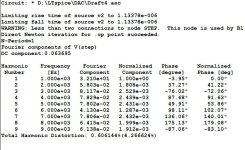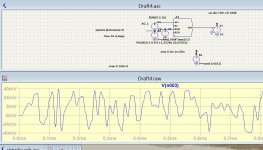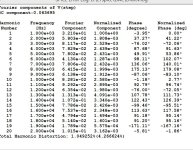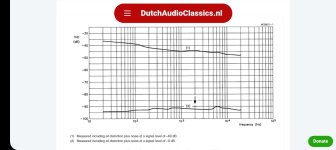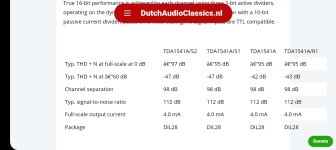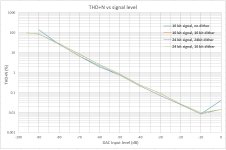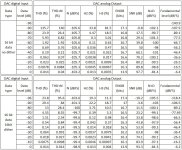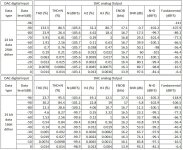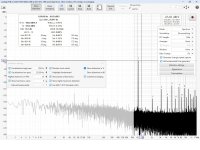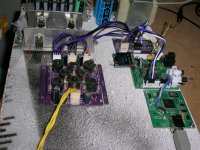That figure includes noiseThe TDA1305 1bit DAC says 0.6% for -60db but not specified with how many bit data.
"total harmonic distortion
plus noise-to-signal ratio"
When you play back 24 bit files over a 16 bit DAC without any dithering, extremely soft passages played back at very high volumes will indeed sound bad. Most recordings don't have such extremely soft passages, though.
Hi Hayk
I have one or two DACS in working condition with multiple // TDA1387 ICs .
Please specify the testing conditions that fit your idea and I will try to do those tests.
George
I have one or two DACS in working condition with multiple // TDA1387 ICs .
Please specify the testing conditions that fit your idea and I will try to do those tests.
George
Isn't THD measured with the summed RMS energy at the harmonic frequencies? As there is (quantization and dither) noise at these frequencies this will not be 0%?Theoretically 0 %. There are quantization errors, but with proper dithering and a perfect DAC, that is counted as noise rather than distortion.
In principle, for THD, you use a narrowband measurement at each harmonic frequency, calculate the RMS sum and compare it to the fundamental. When you let the measurement bandwidth approach zero, the RMS value of the noise in that bandwidth also approaches zero, so the measured THD also approaches zero when there is no distortion, only noise.
Of course there are practical limitations why you can't let the measurement bandwidth approach zero in real life, but my reply was about the theoretical limit - which is 0 %.
Of course there are practical limitations why you can't let the measurement bandwidth approach zero in real life, but my reply was about the theoretical limit - which is 0 %.
H
HAYK
You are very generous, George, it will help many of us.
The 2.2% THD+N for -60db in DS is measured at high sample frequency. What is good to know, what is the THD+N with and without dither and 16bit 44.1khz input for 0db and -60db?
Please precise the number of //DACs.
H
HAYK
H
HAYK
I was wrong with the THD. I have measured only 9 harmonics where 20 should.I get 1% now for 1khz and 200hz 100 harmonics.
With 200hz I again added dither noise 60mvP and got 1.6%. Maybe the dither is measured with many cycles but how many? I tested with 100cycles, the same 1.6%.
Now I am scratching my head, 6bit should be 36db, DAC measure 42db and simulator says 40db.
PS. I have 33 steps as 0 and +/-32 levels.
With 200hz I again added dither noise 60mvP and got 1.6%. Maybe the dither is measured with many cycles but how many? I tested with 100cycles, the same 1.6%.
Now I am scratching my head, 6bit should be 36db, DAC measure 42db and simulator says 40db.
PS. I have 33 steps as 0 and +/-32 levels.
Attachments
Last edited by a moderator:
H
HAYK
The THD+N measurements are also decreased by oversampling. The TDA1541a data shows for NOS vs theoretical.

This clearly shows less than -40db and theoretical as I measured by simulator.
The bellow numbers are for oversampled.
The theoretical curve shows -98db for 0db instead of -96. I conclude the equation is 6db/bit+3db.
This clearly shows less than -40db and theoretical as I measured by simulator.
The bellow numbers are for oversampled.
The theoretical curve shows -98db for 0db instead of -96. I conclude the equation is 6db/bit+3db.
Attachments
Last edited by a moderator:
The theoretical SINAD for an n-bit undithered quantizer sampled at a frequency fs and measured over a bandwidth B is
n * 20 log10(2) dB + 10 log10(3/2) dB + 10 log10(fs/(2B)) dB
The second term comes from the difference in probability distribution between the signal, which is assumed to be a full-scale sine wave, and the quantization error, which is assumed to be uniformly distributed over 1 LSB.
n * 20 log10(2) dB + 10 log10(3/2) dB + 10 log10(fs/(2B)) dB
The second term comes from the difference in probability distribution between the signal, which is assumed to be a full-scale sine wave, and the quantization error, which is assumed to be uniformly distributed over 1 LSB.
Last edited:
I was wrong with the THD. I have measured only 9 harmonics where 20 should.I get 1% now for 1khz and 200hz 100 harmonics.
With 200hz I again added dither noise 60mvP and got 1.6%. Maybe the dither is measured with many cycles but how many? I tested with 100cycles, the same 1.6%.
Now I am scratching my head, 6bit should be 36db, DAC measure 42db and simulator says 40db.
PS. I have 33 steps as 0 and +/-32 levels.
Maybe LTSpice assumes the signal to be periodic and just looks at the last period of the 1 kHz?
Without dither, the signal is actually periodic with a period determined by the beat frequency of the signal and the sample rate, that is, 10 ms, 100 Hz, for 1 kHz and 44.1 kHz. With dither, it isn't periodic at all.
What do you get when you look at the spectrum over the 100 cycles using a Hann window?
According to a Tony Casey on this page https://groups.io/g/LTspice/topic/50203142 the LTSpice white function produces clipped Gaussian noise. Ideally dither should be 2 LSB peak-peak with a triangular probability distribution, which you get when you add two independent uniformly distributed random signals of 1 LSB peak-peak.
Hi HaykWhat is good to know, what is the THD+N with and without dither and 16bit 44.1khz input for 0db and -60db?
Please precise the number of //DACs.
I did the tests which I hope are close to what you were asking.
My testing capabilities give results which are far away from the theoretical limits I read discussed above.
As a DUT I used the assembly around the Dark LED concept of Abraxalito
https://www.diyaudio.com/community/...er-i-v-stage-for-nos-dacs.395208/post-7253630
A CM6631A USB to I2S board, then an AK4113VF digital interface, then a very simple four TDA1387 in parallel as the DAC, then a 9th order LC filter, a passive I/V, and a buffer.
A 1050Hz sinusoidal digital signal from a battery powered laptop drives the USB.
An EMU 0404 acts as the ADC connected to another PC.
REW on the receiver side is set to 44.1kHz/24 bit.
REW on the generator side is set to:
44.1kHz/16bit no dither
44.1kHz/16bit 16bit dither
44.1kHz/24bit 24bit dither
44.1kHz/24bit 16bit dither
My results show that it is the bit depth of the applied dither that determines the THD at low levels, not the data bit depth that feeds the TDA1387.
(REW adds 2 LSB pk-pk triangular dither)
George
Attachments
Makes sense; the TDA1387 is a 16 bit DAC, so when you try to apply a signal with a longer wordlength to it, it will round it off to 16 bit anyway. With the dither that is appropriate for 16 bit requantization, the round-off error will be similar to noise rather than distortion.
H
HAYK
Thank you George, thank you very much. Lot of information to learn from.
First, paralleling doesn't pay. The (D+N)/S at -60db is -33.3d vs -33db typ. in the DS.
The THD+N at -60db of 1.8% measured with192khz sampling rate, didn't increase with 44.1khz, does it means if it remained nearly the same is due to paralleling or for less glitches?
Because of dither, the noise doubled, +6db but the THD decreased significantly only at -80db, is it really audible?
First, paralleling doesn't pay. The (D+N)/S at -60db is -33.3d vs -33db typ. in the DS.
The THD+N at -60db of 1.8% measured with192khz sampling rate, didn't increase with 44.1khz, does it means if it remained nearly the same is due to paralleling or for less glitches?
Because of dither, the noise doubled, +6db but the THD decreased significantly only at -80db, is it really audible?
First, paralleling doesn't pay.
I'm reading George's FFT (5th pic) and from that it does pay in terms of noise, SNR -105.6dB vs DS of 95dB (non-A weighted). It doesn't pay in distortion terms I would agree and that's likely because the bit weights aren't randomly distributed as they'd likely be in an R2R DAC, there's significant systemic error which doesn't change between chips.
H
HAYK
The fundamental is not 0db, it is -6db. The noise becomes 105-6=99db.
The DS says 98db.
There is an error in table 16bit. The THD 1.9% and THD+N is also 1.9%. On FFT it says 2.17%. with 20khz BW. The DS gives typical 1.8% with A weighted which is 80khz BW.
The FFT shows about 1/3 of the harmonics to be even ones that I might reduce them considerably by differential on same chip. What I am unable to determine when the MSB enters in action. Normally it occurs at bipolar 0 but the 1387 is offseted. Normally it should be at 3/4 level, which is about -3db. The 1545 DS gives the following linearity curve, that looks to be at -10db and also with George's measurements but highly exaggerated. Is it because paralleled that made it worst?

The DS says 98db.
There is an error in table 16bit. The THD 1.9% and THD+N is also 1.9%. On FFT it says 2.17%. with 20khz BW. The DS gives typical 1.8% with A weighted which is 80khz BW.
The FFT shows about 1/3 of the harmonics to be even ones that I might reduce them considerably by differential on same chip. What I am unable to determine when the MSB enters in action. Normally it occurs at bipolar 0 but the 1387 is offseted. Normally it should be at 3/4 level, which is about -3db. The 1545 DS gives the following linearity curve, that looks to be at -10db and also with George's measurements but highly exaggerated. Is it because paralleled that made it worst?
Last edited by a moderator:
The DS says 98db.
That's an A-weighted figure manufacturers love to quote because it improves the numbers. Subtract 3dB for a more realistic unweighted result.
H
HAYK
A weighted if I remember is 80khz BW. It might be 3db less without filter. Here George has limited his BW to 20khz to get 99db, if 80khz, it could be 97db.
To concider that when a recorded dithered signal is introduced, the noise level doubles.
To concider that when a recorded dithered signal is introduced, the noise level doubles.
- Home
- Source & Line
- Digital Line Level
- 16 bit DAC AT-60DB
